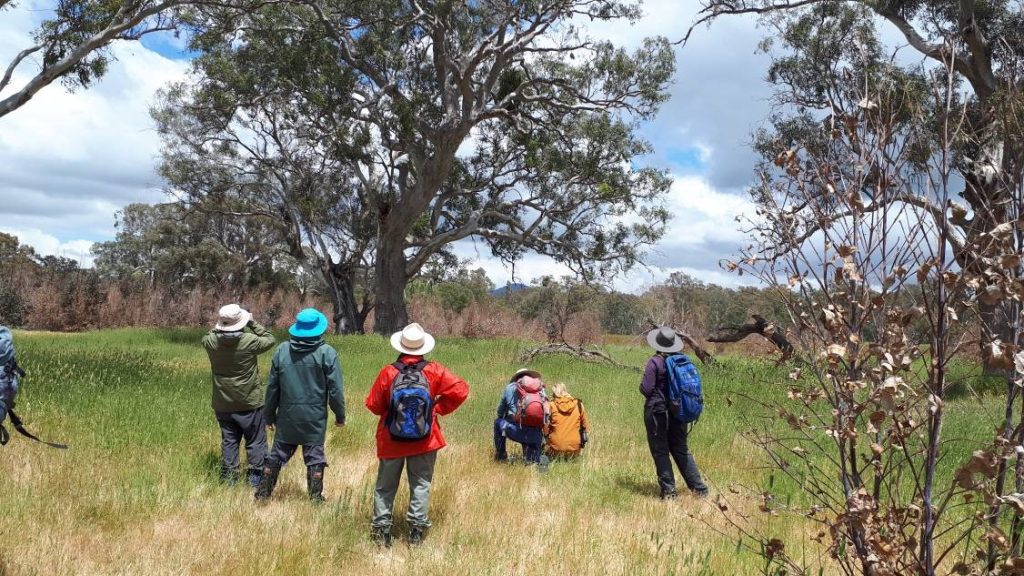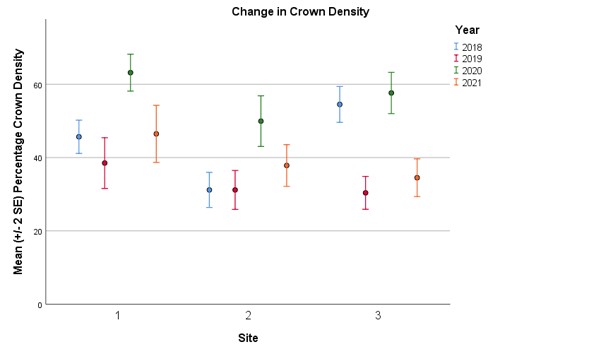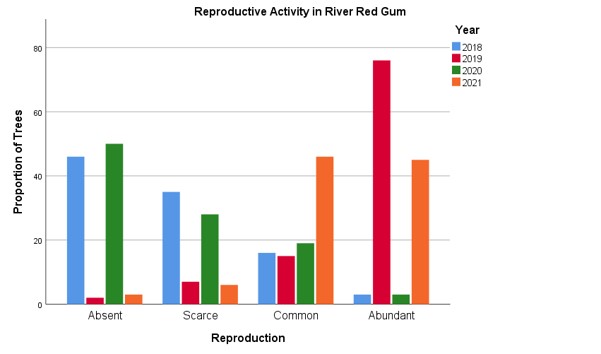River Red Gums at Walker Swamp: Four years of data now shows a biennial flowering cycle
As part of a new program to involve volunteers in monitoring at Walker Swamp, and kick started through the Victorian Government’s 2021 Community Volunteer Action Grants, an intrepid group of eager but amateur ecologists (I am sure they won’t mind me calling us all that!) set out to learn the fine art of River Red Gum assessment from NGT Senior Ecologist, Greg Kerr. And as always, Greg taught us so much more than we expected to learn!

Fortunately, the weather on the day was very miled, as we took a while to grasp the process and wind our heads around the parameters we were to measure. The bird life around us was, as always, spectacular, and the trees we were measuring were steadfastly inspiring – as we learnt each measurement, we had more and more respect and quiet admiration for the trees, not to menthion the conditions and pests they were coping with.
There are 100 trees marked at Walker Swamp, and each one is being assessed every year. This is a program which will be expanded to other NGT reserves, and again, an invitation to learn and help record this information will be extended to you all.
Two years ago we reported on the condition of River Red Gums at Walker Swamp following the completion of the second annual visual assessment survey of the marked trees (you can find that article here). At that time the majority of trees were rated as being in good or very good condition. We now have four years of data and some interesting results to digest.
After three years of gradual improvement at most sites, the average condition of the trees has dropped markedly in 2021 (Figure 1).

This decline in overall condition was mainly driven by a loss of leaves in the tree crown (Figure 2) across all sites with high levels of insect attack.

Despite the elevated canopy damage and leaf loss, there was a very high level of reproductive activity in the River Red Gums this year (Figure 3), with 91 of the 100 trees having buds, flowers, and/or fruit throughout the canopy. For over half of these trees the reproductive effort dominated the canopy.

The extremely high level of reproductive effort across the vast majority of trees repeats that observed in 2019, but it contrasts with the very low level, or absence, of reproduction seen in both 2018 and 2020. Importantly, there may be a link between the condition of crown in the previous year and the reproductive effort in the following year. Certainly an observation worthy of further investigation.
As discussed two years ago, it may be that the River Red Gums are showing a postulated biennial cycle of flowering (Souter et al. 2009). If this is the case, the relatively low level of flowering and fruiting seen in both 2018 and 2020 may be due to the trees being in a low reproductive year, in a landscape-scale biennial flowering cycle. This raises many questions: is this cycle just coincidental and driven by climate or other environmental factors or is it a coordinated effort by the River Red Gums? If it is coordinated, how do they do it – and why?
It will be really rewarding to follow these trees through the years, and watch how they cope with changing water levels, removal of blue gum plantations, climate change, and insect and pest infestations.
And it’s important to say, that we got faster at our monitoring, and finished the 100 trees by 3pm the following day (and that included sheltering from a sudden hailstorm!). The drive home was slow, as we were continually looking out the windows, using our newfound skills to assess all the trees as we passed!
This coordinated monitoring approach is a great skill to learn, and a few of us have already gone home and started identifying and recording those trees we have living around us.
Have a wonderful Christmas everyone, and a lovely and safe Summer. We will be back in 2022 with more activities and opportunities for you to be involved in.
References:
Souter, N. J., R. A. Watts, M. G. White, A. K. George, and K. J. McNicol. 2009. Method manual for the visual assessment of lower River Murray floodplain trees. River Red Gum (Eucalyptus camaldulensis). February 2009. Government of South Australia, through Department of Water, Land and Biodiversity Conservation., Adelaide.
This activity was part of a new volunteer program, “Increasing diversity among environmental volunteers at Walker Swamp” which is supported by the Victorian Government through the 2021 Community Volunteer Action Grants.
